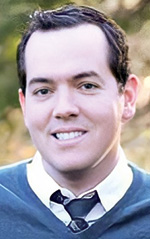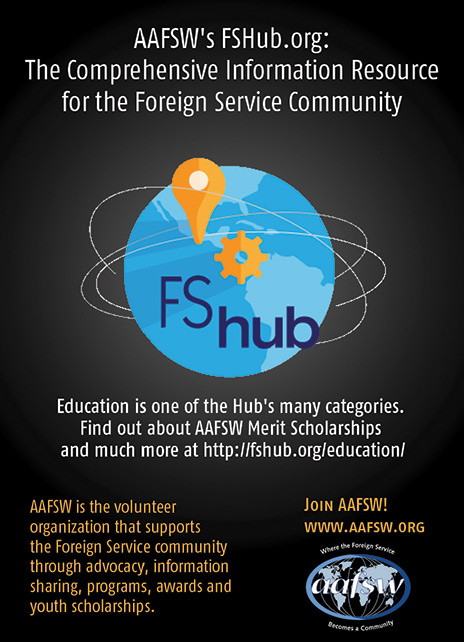“Winning the Competition for Talent”—The Case for Expanding the Diplomat in Residence Program
Speaking Out
BY BRENDAN RIVAGE-SEUL
Speaking Out is the Journal’s opinion forum, a place for lively discussion of issues affecting the U.S. Foreign Service and American diplomacy. The views expressed are those of the author; their publication here does not imply endorsement by the American Foreign Service Association. Responses are welcome; send them to journal@afsa.org.
I read with interest Deputy Secretary of State for Management and Resources Brian McKeon’s email blast to all State Department personnel earlier this year that carried the subject line: “Winning the Competition for Talent.” In it, “D-MR” touted the department’s numerous reforms in the past 12 months aimed at workforce retention and recruiting the next generation of U.S. foreign policy professionals.
State’s latest initiatives focused on retention (e.g., expanded remote work eligibility, more flexible options for leave without pay, tracking data from exit interviews) are promising—and long overdue. And the expansion of Pickering, Rangel, and Payne (USAID) Fellowship programs focused on diversity recruitment are welcome.
However, if our goal is to have a workforce that truly reflects the American people—and includes “talented people from all walks of life”—there is a compelling case for expanding and revamping the Diplomat in Residence (DIR) program, as well. Organizational diversity starts with recruitment and selection—and is solidified through retention: The two go hand in hand.
Consider that no matter how well State does with retention, it will not fundamentally change the current Foreign Service demographics. According to the latest figures from AFSA, Foreign Service ranks—white men excluded—consist of women (37 percent), African Americans (8 percent), Asian Americans (7 percent), and Hispanics or Latinos (8 percent).
A Foreign Service that “looks like America” would, by contrast, track more closely with our nation’s demographics, which per the latest U.S. census data break down as follows: women (50.5 percent), African Americans (13.6 percent), Asian Americans (6.1 percent), and Hispanics or Latinos (18.9 percent).
These figures signal that, with the exception of one non–white male category, we clearly need more diversity in our pool of successful Foreign Service applicants (i.e., those who ultimately become U.S. diplomats). Expanding and rethinking our recruitment strategies would seem an obvious place to start.
After speaking with several colleagues who have served recently as DIRs, I am convinced that to attract the most talented and diverse group of Foreign Service candidates who can make it through the rigorous selection process, our DIR team must become much bigger, more strategic, proactive, and data-driven. We must also equip DIRs with better resources, recruitment tools and technology, metrics, and accountability mechanisms to track their success in boosting the numbers of successful candidates from underrepresented groups.
Here I should add that my conversations with former DIRs left no question that they are doing well-intentioned, admirable work—and naturally trying to focus on diversity recruitment. But there is so much more the department could be doing to set them up for success.
The good news is we do not need to reinvent the wheel. Instead, the department can take a page from the recruitment playbooks of other successful nonprofit and government organizations that have made huge diversity gains in recent years, including Peace Corps, City Year, Teach For America, and even the U.S. military.
Recruit Like a Nonprofit
Before I joined the Foreign Service, I worked as a recruitment director at Teach For America (TFA). TFA invested heavily in its professional recruitment operations (including training), and many parts of its model seem applicable to the State Department and worth emulating.
At TFA we had 50 regional recruitment directors, 50 recruitment associates, and hundreds of paid interns spread across top university campuses throughout the country. In contrast, the department currently has just 14 Diplomats in Residence who receive minimal administrative support. One former DIR told me he spent “nearly half” of his time on administrative tasks related to travel (e.g., filling out mileage reimbursement forms and fighting with the E2 travel system).
Much like at State, our mission at TFA was to recruit the most talented, diverse group of public service–oriented applicants possible. Unlike the State Department, however, our TFA recruitment team had specific numeric goals and metrics for every diversity category imaginable.
Our “fundamental framework” at TFA was straightforward: 1) find the right people; 2) get in front of them; 3) invest them in the organization’s mission; and 4) convince them to apply and then matriculate.
Interns helped us find the most talented and diverse student leaders on campus; recruitment associates helped schedule meetings with those individuals and manage travel; and recruitment directors met the prospective applicants, gave them the pitch, and remained their point of contact throughout the application and matriculation process.
We used Salesforce software to build applicant profiles and track data on all our outreach and interactions. Colleagues who have worked recently as DIRs confirm that the department keeps no such comprehensive data on prospective applicants, nor does it have a well-developed screening process for determining which potential applicants DIRs should meet.
During my final year as a recruitment director, we increased applications to Teach For America from 18,000 to 24,000, and had the most ethnically and geographically diverse, gender-balanced group of corps members (4,000 applicants were ultimately admitted and accepted) in the organization’s history.
At more than 120 colleges and universities, including several historically Black colleges and universities (HBCUs), more than 5 percent of the senior classes applied, including 12 percent of all seniors at Ivy League schools, 7 percent of the graduating class at the University of Michigan–Ann Arbor, and 6 percent at the University of California–Berkeley. The State Department could easily achieve comparable results, though with a greater focus on graduate students.
Imagine a Different Kind of State
I share this detailed background about my experience as a recruiter at TFA because, for too long, the department has taken for granted that it will continue to naturally generate tens of thousands of applications for the Foreign and Civil Service without doing or changing much of anything.
The hard truth is we have not been nearly forward-leaning enough about finding the right people, getting in front of them, and convincing them to take the FSOT and Presidential Management Fellow (PMF) exam and join the Foreign and Civil Service.
Imagine, though, if we quadrupled the size of the DIR program from 14 to 56 officers and took a more systematic, data-driven approach to recruitment operations with a laser focus on increasing the diversity (ethnic, gender, geographic, and socioeconomic) and excellence of our applicant pool.
Unlike the State Department, however, our TFA recruitment team had specific numeric goals and metrics for every diversity category imaginable.
We could have a critical mass of well-trained, mid-level diplomat recruiters (with proper administrative support) in every state and most major urban centers tasked with finding the next generation of talented, diverse Foreign Service officers and specialists and Civil Service staff. DIR positions are already highly sought after among FS-2 and FS-1 bidders, which would no doubt continue to be the case with more positions available.
Imagine, too, if the DIR launched a paid internship program for college and graduate students at top universities across the country to assist with identifying and recruiting the right applicants for the Foreign Service, including by scouring online professional networking platforms such as LinkedIn, Twitter, and Jobcase.
From experience, I can tell you that having interns who were themselves students at the universities we are targeting and who knew (or could help us find out) who were the top diverse student leaders on campus and online was essential to our recruitment success at TFA. Alumni of those DIR internships would also, naturally, become an additional talent pipeline for the Foreign Service.
Critics of the idea of expanding the DIR program will naturally question how the department could afford to commit to dozens of new domestic positions when we have staffing shortages overseas. The self-evident response is: How can we afford not to?
Consider, too, that State’s Fiscal Year 2022 budget proposed an additional 500 positions for the Foreign and Civil Service. If we genuinely aspire to achieve the diversity, equity, inclusion, and accessibility (DEIA) goals articulated by the Secretary, it follows we must do everything possible to make sure these new hires (and those in the years ahead) are the most diverse and qualified possible.
Move the Needle
D-MR’s email noted that in the past year, the department conducted more than 3,000 recruiting activities, including more than 900 events specifically targeting diversity prospects, which engaged 15,000 individual prospects.
His email also touted the department’s new 500-person Volunteer Recruiter Corps who participated in 150 events. Though impressive sounding and well intentioned, I fear these initiatives alone are unlikely to move the needle.
During my final year as a recruitment director at TFA, I and my colleagues met one-on-one with 50,000 individuals. Through in-person and online group information sessions, we collectively engaged with another 150,000 prospective candidates.
Our Salesforce entries helped us document who these applicants were and their motivations, interests, and barriers to applying. Importantly, it also helped us tailor our follow-up to encourage the most promising prospects to apply, including by connecting them with current corps members or alumni who had a shared profile or interests.
We should be doing the same with prospective Foreign and Civil Service applicants. Convincing someone to apply for a position within a given organization is, at its core, about influencing and motivating (something we diplomats get paid to do), identifying barriers, and knocking them down.
Our data-driven approach at Teach For America also helped us stay accountable.
A First Step
Adding 42 officers to the Diplomat in Residence roster will help, but that is only the first step to “winning the competition for talent.” Equally imperative is setting our new DIRs up for success by giving them extensive training in professional recruitment practices, providing them with tracking tools and administrative support, and ultimately holding them accountable for the successful applications (and profiles of applicants) they generate.
DIR assignments should no longer be viewed as low-key sabbaticals or pre-retirement tours. We also need to make sure the most effective DIRs are incentivized (and recognized) when it comes to promotions and onward assignments.
Promisingly, the department’s current leadership is genuinely committed to increasing diversity within the Foreign and Civil Service. However, a trap we must all avoid is spending too much time talking about the problem and not enough time solving it.
It is time for action, and revamping and expanding the DIR program would be a good place to start.
When sharing or linking to FSJ articles online, which we welcome and encourage, please be sure to cite the magazine (The Foreign Service Journal) and the month and year of publication. Please check the permissions page for further details.
Read More...
- “For an ‘Administrative’ Dissent Channel” by Brendan Rivage-Seul, The Foreign Service Journal, April 2021
- “An Interview with Tulane’s Diplomat in Residence: Nathan Bland” by Hunter Jones, Newcomb-Tulane College, August 2021
- “State U—A Proposal for Professional Diplomatic Education and Outreach to America” by Joel Ehrendreich, The Foreign Service Journal, July/August 2021
- “Modernizing Our Workforce and Winning the Competition for Talent” by Brian McKeon, U.S. Department of State DipNote, January 25, 2022







